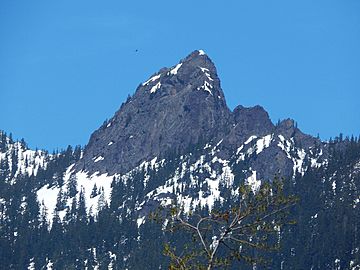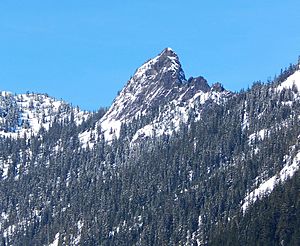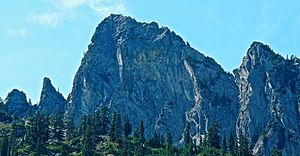The Tooth (Washington) facts for kids
Quick facts for kids The Tooth |
|
|---|---|

The Tooth seen from eastbound Interstate 90
|
|
| Highest point | |
| Elevation | 5,604 ft (1,708 m) |
| Prominence | 244 ft (74 m) |
| Geography | |
| Parent range | Cascade Range |
| Topo map | USGS Snoqualmie Pass |
| Type of rock | Andesite |
| Climbing | |
| Easiest route | Scrambling class 4 |
The Tooth is a cool mountain peak in Washington state, USA. It's shaped like a fin and stands 5,604 feet tall. This rocky pillar is made of a type of rock called andesite.
You can find The Tooth in King County, as part of the Cascade Range. It's also inside the Alpine Lakes Wilderness, a protected natural area. The mountain is northwest of Snoqualmie Pass and the Alpental ski area. It's managed by the Mount Baker-Snoqualmie National Forest.
The Tooth got its official name in 1918. Before that, people called it Denny Horn or Denny Tooth. The name "Denny" comes from its spot on a ridge between Denny Mountain and Chair Peak. The mountain is a very popular place for rock climbing, even in winter! The easiest way to get to the top is by scrambling, which is like a mix of hiking and climbing. More experienced climbers enjoy its challenging routes, like the South Face, first climbed in 1928.
Weather at The Tooth
The Tooth is located in a "marine west coast" climate zone. This means it gets a lot of weather from the Pacific Ocean. Most weather fronts move east towards the Cascade Mountains.
When these weather fronts hit the tall Cascade Mountains, they are forced to rise. This causes them to drop their moisture as rain or snowfall onto the mountains. This process is called Orographic lift. Because of this, the western side of the Cascades gets a lot of rain and snow, especially in winter.
During winter, it's often cloudy. But in summer, high-pressure systems over the Pacific Ocean usually bring clear skies. The snow here tends to be wet and heavy due to the ocean's influence. This can lead to a high risk of avalanches. All the water from The Tooth eventually flows into the Snoqualmie River.
How The Tooth Was Formed
The Alpine Lakes Wilderness, where The Tooth is, has very rugged land. You'll see jagged peaks, deep valleys carved by glaciers, and tall granite walls. There are also over 700 mountain lakes! All these different features and big changes in height were created by geological events over millions of years.
The Cascade Range started forming a very long time ago, in the late Eocene Epoch. This happened when the North American Plate slowly moved over the Pacific Plate. This movement caused many volcanic eruptions. Also, small pieces of the Earth's crust, called terranes, helped build the North Cascades about 50 million years ago.
Later, during the Pleistocene period (which started over two million years ago), huge sheets of ice called glaciers moved across the land many times. As they moved, they scraped and shaped the landscape, leaving behind rocks and debris. The last glaciers in the Alpine Lakes area started melting about 14,000 years ago.
The "U"-shaped valleys you see today were carved out by these glaciers. The combination of land being pushed up (orogeny) and cracks in the Earth's crust (faulting), along with the glaciers, created the tall peaks and deep valleys of the Alpine Lakes Wilderness.





